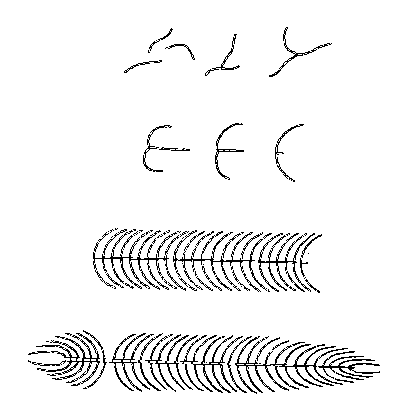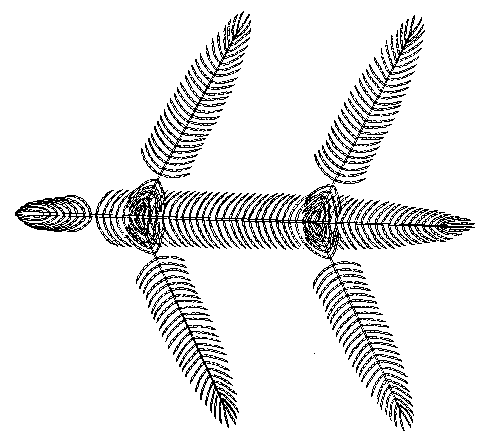In this section a scenario is described for the evolution of the progenitors of segmented organisms. It is based on the forms of segmented animals, on the observable evolutionary pattern of reduction and specialization among segments, and certain theoretical considerations.
The theory begins with an unsegmented metazoan, a creature with roughly the anatomical complexity of a mollusk. It is physiologically complex and skeletally simple. It lives in a primordial sea, an ocean without segmented organisms. Yet here there is competition and predation, and sheer size is advantageous. But there are difficulties in evolving larger size. A modest increase in size may require drastic anatomical and behavioral adjustments. A quick and easy way to evolve some of the advantages of larger size is to form a chain of identical organisms through parabiotic mutation. At first, each segment of this grouping would be self-sufficient, even though fused to adjoining segments in certain soft tissues. Hard parts could remain free or articulated. Segmentation offers a combination of hardness and flexibility, like a jointed suit of armor. Such a grouping has the potential for advances in locomotive capability, for improved capability in offense, defense, and dispersal, as segments gradually evolve the ability to coordinate their muscular actions.
Through parabiosis, an organism consisting of a chain of identical organisms is formed. Through evolutionary reduction, the segments of the chain become differentiated structurally from one another, while their interdependence increases. Circulatory and nervous systems fuse and communicate. Finally a segmented worm evolves with one digestive system and lead segments with special responsibilities for perception and ingestion.
The formation of the more complex arthropods and vertebrates requires additional steps of parabiotic mutation and subsequent reduction. To create the basic arthropod form, the chain-organism is itself multiplied, as in the Figure 1, or through some similar process. Out of various possibilities, natural selection favors a form with a segmented axial skeleton with segmented radials branching to the sides. Again, size is increased, and new possibilities arise for specialized organs to evolve through the adaptive distortion of segments. The progenitor consists of many symmetrical unspecialized parts, a nascent mass of morphological raw material.
Fig.1. Formation of axis with biserial radials through parabiosis.

The segmented biserial radials come to serve as rowing organs; some of them, in some lineages, evolve into legs and pincers. Anterior radials become antennae, jaws, and other organs of the head. From this basic arthropod form, the entire range of arthropods evolves through the comprehensible and observable process of reduction and distortion.
This sort of speculation regarding the evolution of arthropods is common in evolutionary biology, and related ideas regarding homologies within vertebrates were even considered by pre-evolutionary anatomists. The proposed model differs from these precursors in that it affirms all these points:
- The formation of the prototype is rapid, through parabiotic macromutation.
- Complexity in the sense of number of skeletal parts is only increased by crude parabiotic mutations, not by mutations that cause new individual buddings of segments in the embryo.
- The homologizing of segments is total, extending even to the appendicular segments of vertebrates.
- The axial skeleton is homologized with the appendicular skeletons.
- Archetypes are clearly delineated and defended as proper ideas within a specific context where change is limited to reduction and distortion.
- After the formation of the prototype, subsequent evolution proceeds only through reduction and distortion of segments. After the evolution of a specialized form, further parabiotic mutations are unlikely to be successful, but remain theoretically possible.
The evolution of the vertebrate requires additional steps of parabiotic mutation. The segmented axis with segmented biserial radials (Fig.1) is itself multiplied; it is longitudinally fused with another such structure. Then two such complexes are attached along the axis. The ends of these two appendicular pairs bend apart, forming four limbs. From the resultant organism (Fig.2) evolution proceeds in the observable mode of reduction and distortion, forming the range of vertebrate forms.
Fig.2. Protovertebrate, top view; dorsal axial radials are omitted.

The anterior radials of the main axis take on sensory and manipulative roles. Eventually they fuse to form the skull. The presently observable articulations in vertebrate skulls (jaws, auditory ossicles, and cranial articulations) are vestiges of this more articulated primitive condition, in which the head consists of many symmetrical segments. Axial segments posterior to the head form vertebrae; their associated radials form ribs and axial fin rays (in fin seams, and in caudal and anal fins). The appendicular structures evolve into the various vertebrate limbs; their radials evolve into digits and fin rays. The proximal parts of these proto-limbs fuse to form the anchoring girdles of the limbs. These skeletal transformations are discussed in a little more detail in the following sections.
Arthropods have exoskeletons, vertebrates endoskeletons. This is not a critical point for the proposed general morphological theory. A primitive aquatic ancestor could make a gradual transition from one condition to the other; this would only be an amorphous migration and envelopment of one type of tissue by another. It is not suggested that any creature we call an arthropod is a vertebrate ancestor, only that the vertebrate skeletal structure was built by compounding segmented skeletal structures analogous to the basic arthropod form--a segmented axis with segmented biserial radials.
The mechanism of formation of complexes through duplication of parts operates repeatedly at different levels. This is reminiscent of fractal pattern generation, where the same formula operates at different levels. If fractals were more generally understood, 'fractal evolution' might be applied to this process.
forward to The Vertebrate Skull